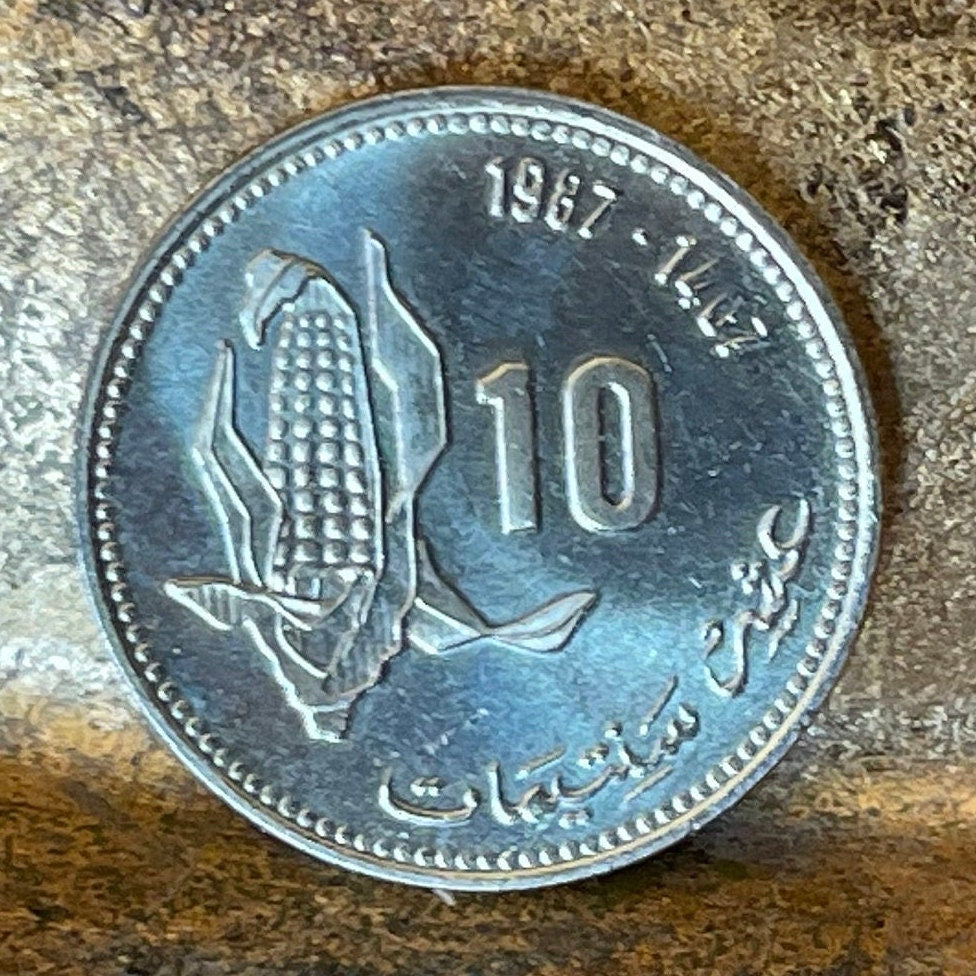elemintalshop
Ear of Corn 10 Santimat Morocco Authentic Coin Money for Jewelry and Craft Making (FAO)
Ear of Corn 10 Santimat Morocco Authentic Coin Money for Jewelry and Craft Making (FAO)
Couldn't load pickup availability
Ear of Corn 10 Santimat Morocco Authentic Coin Charm for Jewelry and Craft Making (FAO)
Commemorative issue: F.A.O. (United Nations Food and Agriculture Organization)
Obverse: Crowned arms with supporters
Lettering:
المملكة المغربية
إن تنصروا الله ينصركم
Translation:
The Kingdom of Morocco
If you support God, he will help you
Reverse: Single ear of corn to left of value, dates top right
Lettering:
1987 - 1407
10
عشر سنتيمات
Translation: Ten Centimes
Features
Issuer Morocco
King al-Hassan II (1961-1999)
Type Circulating commemorative coin
Year 1407 (1987)
Calendar Islamic (Hijri)
Value 10 Centimes
0.10 MAD = 0.011 USD
Currency Dirham (1960-date)
Composition Aluminium-bronze
Weight 3.00 g
Diameter 20 mm
Thickness 1.28 mm
Shape Round
Orientation Coin alignment ↑↓
Number N# 2321
References Y# 84, Schön# 90
Wikipedia:
Morocco is endowed with numerous exploitable resources. With approximately 85,000 square kilometres (33,000 sq mi) of arable land (one-seventh of which can be irrigated) and its generally temperate Mediterranean climate, Morocco's agricultural potential is matched by few other Arab or African countries. It is one of the few Arab countries that has the potential to achieve self-sufficiency in food production. In a normal year Morocco produces two-thirds of the grains (chiefly wheat, barley, and corn [maize]) needed for domestic consumption. The country exports citrus fruits and early vegetables to the European market; its wine industry is developed, and production of commercial crops (cotton, sugarcane, sugar beets, and sunflowers) is expanding. Newer crops such as tea, tobacco, and soybeans have passed the experimental stage, the fertile Gharb plain being favourable for their cultivation. The country is actively developing its irrigation potential that ultimately will irrigate more than 2,500,000 acres (10,000 km2).
************
Wikipedia:
The government of Morocco describes the coat of arms as follows:
Gules, in chief a demi-sun rising, with 15 rays or on a background azure; supported by a fess in bar enarched vert, fusily or and argent; the whole surcharged by a mullet (pentalpha) vert. The shield ensigned by the Royal Crown of Morocco or, embellished with pearls alternately gules and vert; it is bordered with lamrequins or, sustained on 2 cornucopias and supported by two lions proper: the one in dexter in profile and in sinister affronté.
The shield has a scroll or with a verse from Quran: In Tansourou Allaha Yansouroukoum
************
World Food Day is an international day celebrated every year worldwide on 16 October to commemorate the date of the founding of the United Nations Food and Agriculture Organization in 1945. The day is celebrated widely by many other organizations concerned with hunger and food security, including the World Food Programme and the International Fund for Agricultural Development. WFP received the Nobel Prize in Peace for 2020 for their efforts to combat hunger, contribute to peace in conflict areas, and for playing a leading role in stopping the use of hunger in the form of a weapon for war and conflict.
**************
Wikipedia:
Maize has been an essential crop in the Andes since the pre-Columbian era. The Moche culture from Northern Peru made ceramics from earth, water, and fire. This pottery was a sacred substance, formed in significant shapes and used to represent important themes. Maize was represented anthropomorphically as well as naturally.
In the United States, maize ears along with tobacco leaves are carved into the capitals of columns in the United States Capitol building. Maize itself is sometimes used for temporary architectural detailing when the intent is to celebrate the fall season, local agricultural productivity and culture. Bundles of dried maize stalks are often displayed along with pumpkins, gourds and straw in autumnal displays outside homes and businesses. A well-known example of architectural use is the Corn Palace in Mitchell, South Dakota, which uses cobs and ears of colored maize to implement a mural design that is recycled annually. Another well-known example is the Field of Corn sculpture in Dublin, Ohio, where hundreds of concrete ears of corn stand in a grassy field.
A maize stalk with two ripe ears is depicted on the reverse of the Croatian 1 lipa coin, minted since 1993.
Share



















